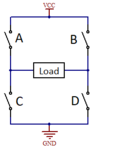Dimitrisvlamis
Member level 2
As you turn off your MOSFET there will be a reverse current from the transformer. In H bridge that is normally passed through the free wheeling diodes.
- - - Updated - - -
No need to lower the PWM frequency, you need to make some arrangement to manage the reactive power during turn OFF. Kindly refer the other inverter whether they have dead band shorting MOSFET's also the pwm frequency.
By dead band shorting you mean a dead time between the end and the start of the opposing signal?
How would this schematic look if I used H bridge? Do I need to change the code or just feed the same signal to the opposite corner MOSFETs? I mean appart from the high side switching driver.


